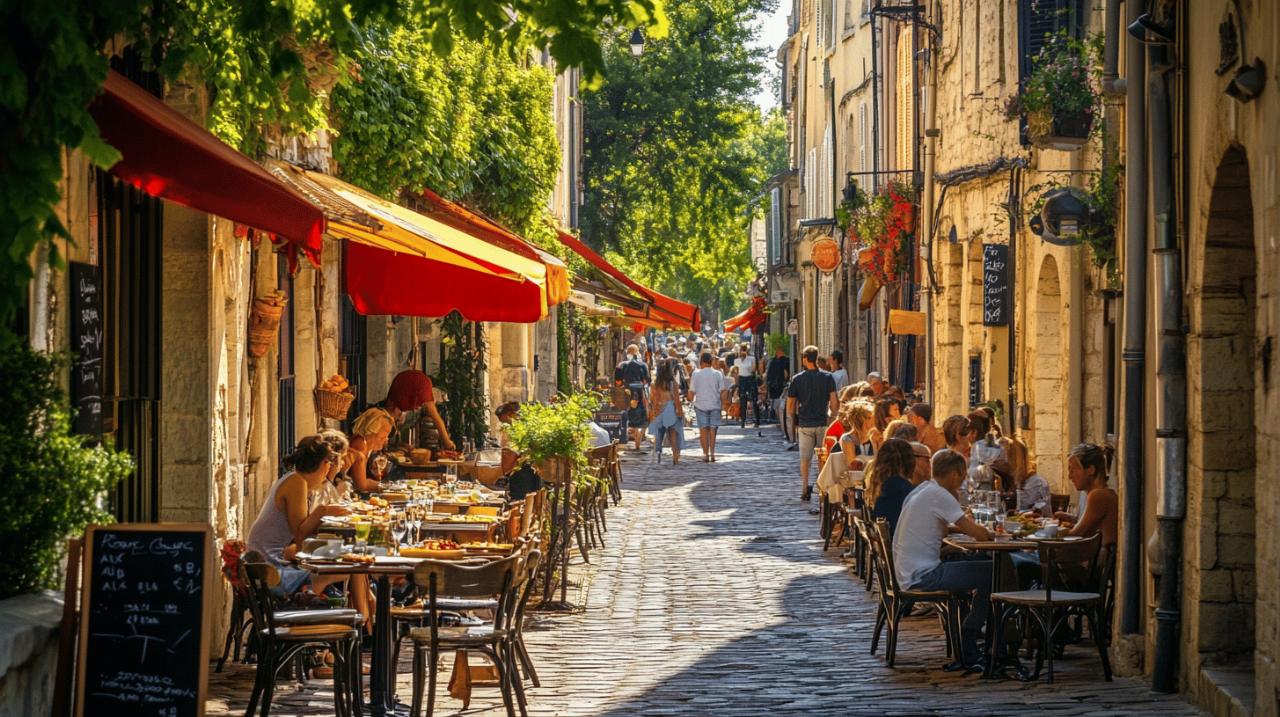Avignon, nestled in the sun-drenched heart of Provence, presents itself as a veritable treasure trove for those who delight in the pleasures of the table. This historic city, renowned for its magnificent papal palace and the iconic bridge immortalised in song, offers far more than architectural splendour. Here, the culinary traditions of southern France thrive amidst cobbled streets and bustling squares, where the aroma of fresh herbs mingles with the scent of baking bread. Whether you're planning a romantic escape, a cultural expedition with mates, or a family adventure, Avignon promises a gastronomic journey that celebrates the very essence of Provençal living, enhanced by the surprising addition of craft beer pairings that bring a contemporary edge to time-honoured recipes.
Avignon's market scene and local produce: a foodie's paradise
The markets of Avignon serve as the beating heart of the city's culinary culture, where locals and visitors alike gather to procure the freshest ingredients that define Provençal cuisine. Unlike the sterile aisles of supermarkets back home, these vibrant gatherings overflow with colour, fragrance, and the passionate voices of vendors extolling the virtues of their produce. The Marché des producteurs de Montfavet stands out as a particular gem, showcasing the dedication of regional farmers who bring their harvest directly to consumers. Here, you'll encounter tomatoes so ripe they seem to glow in the Mediterranean light, herbs that perfume the air with notes of thyme and rosemary, and olives glistening with oil that has been pressed according to methods passed down through generations. The experience transcends mere shopping; it becomes an education in the provenance of food, a connection to the land that nourishes both body and soul.
Navigating the Best Markets in Avignon for Authentic Provençal Ingredients
To truly appreciate the bounty of Provence, one must venture beyond the tourist-heavy thoroughfares and seek out the markets where genuine local character flourishes. The weekly gatherings throughout Avignon offer distinct atmospheres and specialities, each reflecting different aspects of regional abundance. Morning visits prove most rewarding, when the produce remains at its freshest and the stallholders display an eagerness to share their knowledge with curious shoppers. Look for cheeses crafted in nearby farms, their rinds dusted with ash or wrapped in leaves, each variety telling a story of specific terroir and traditional technique. Artisanal chocolates tempt from glass-fronted displays, whilst bottles of wine from small-scale vignerons promise discoveries that no chain retailer could provide. The ritual of market shopping in Avignon encourages a slower, more mindful approach to food, one that values quality over convenience and celebrates the seasonal rhythms that govern agricultural life in this blessed corner of France.
Building the Perfect Picnic: Cheese, Bread, and Olives by the Rhône
Armed with your market treasures, the banks of the Rhône present an idyllic setting for an al fresco feast that captures the essence of Provençal simplicity. Begin with a crusty baguette, still warm from the baker's oven, its golden crust crackling as you tear it into rustic portions. Pair this with a selection of local cheeses, perhaps a creamy chèvre from the hillside pastures or a more pungent sheep's milk variety that speaks of sun-baked grasslands. Olives in various preparations, from the bright green and herb-infused to the wrinkled black specimens cured in brine, provide bursts of concentrated flavour that cleanse the palate between bites. Add some cured meats, a handful of cherry tomatoes that taste of summer itself, and a bottle of chilled rosé, and you've assembled a meal that honours the generous spirit of this region. As you recline beside the flowing water, with the medieval ramparts visible in the distance, such moments remind us that the finest dining experiences often require neither tablecloths nor reservations, only good ingredients and pleasant company.
Essential Provençal Dishes to Sample in Avignon's Restaurants
The restaurants of Avignon showcase the remarkable range of Provençal cuisine, from hearty peasant fare elevated to an art form to innovative interpretations that push traditional boundaries whilst respecting their roots. The city's dining scene reflects centuries of culinary evolution, influenced by proximity to both Mediterranean coastline and Alpine foothills, by historic connections to Italy, and by the agricultural abundance that surrounds this fertile valley. Whether you choose to dine in a bistro tucked along Rue des Teinturiers, that picturesque thoroughfare where water once powered the textile dyeing industry, or in a more formal establishment occupying an eighteenth-century mansion, you'll encounter cooking that prioritises seasonal ingredients, bold flavours, and generous portions that speak to the region's philosophy of hospitality and shared pleasure.
From bouillabaisse to daube provençale: classic regional specialities explained
Bouillabaisse, that legendary fish stew from the Marseille coast, appears on many Avignon menus, though purists might argue about its authenticity this far from the sea. The dish traditionally combines several varieties of Mediterranean fish with saffron, fennel, and orange zest, creating a broth of remarkable depth that gets served alongside garlicky rouille and toasted bread. Ratatouille, far removed from the bland vegetable porridge that term might suggest to the uninitiated, achieves its proper glory when each component is cooked separately before being combined, allowing aubergines, courgettes, peppers, and tomatoes to maintain their distinct characters whilst melding into harmonious unity. Daube Provençale represents the cuisine's more substantial side, a slow-braised beef stew enriched with red wine, olives, and aromatic herbs that fills the kitchen with an intoxicating fragrance during its hours-long transformation. These dishes demonstrate the Provençal gift for coaxing maximum flavour from relatively simple ingredients through patient technique and respect for natural qualities.
Where to Find the Best Bistros and Michelin-Starred Dining Experiences
Restaurant La Violette exemplifies the refined end of Avignon's dining spectrum, occupying an elegant eighteenth-century mansion where diners can enjoy their meals in a courtyard shaded by a century-old tree, surrounded by carefully curated artworks that complement rather than distract from the culinary creations. Such establishments offer tasting menus that showcase the chef's vision, often incorporating unexpected elements whilst maintaining clear connections to Provençal tradition. For those seeking less formal but equally authentic experiences, the area around Place des Corps-Saints provides a revelation. This square remains largely unknown to the tourist hordes who cluster around Place de l'Horloge, yet it harbours restaurants and bars where local residents gather, always a reliable indicator of genuine quality. The Musee du Petit Palais houses a charming tea room within its fifteenth-century walls, perfect for afternoon refreshment after cultural immersion. Meanwhile, Rue du Lima offers diverse options for eating and drinking, from traditional bistros serving robust regional classics to contemporary establishments experimenting with fusion approaches that nonetheless respect their geographical context.
Pairing Craft Beer with Provençal Cuisine: A Modern Twist on Tradition
 Whilst wine remains the traditional accompaniment to Provençal meals, the craft beer revolution sweeping across France has reached Avignon with enthusiasm, offering exciting possibilities for pairing these artisanal brews with regional dishes. This development might initially seem sacrilegious in a region so intimately associated with viticulture, yet beer's diversity of styles, ranging from light and refreshing to dark and complex, provides remarkable versatility when matched with the robust flavours characteristic of southern French cooking. The carbonation and bitterness present in many beer styles can cut through rich, oily dishes in ways that wine sometimes cannot, whilst the maltiness of certain brews complements caramelised elements in slow-cooked preparations. Forward-thinking establishments in Avignon have begun to recognise these synergies, offering carefully curated beer selections alongside their traditional wine lists, acknowledging that modern gastronomy benefits from expanding rather than restricting the options available to curious diners.
Whilst wine remains the traditional accompaniment to Provençal meals, the craft beer revolution sweeping across France has reached Avignon with enthusiasm, offering exciting possibilities for pairing these artisanal brews with regional dishes. This development might initially seem sacrilegious in a region so intimately associated with viticulture, yet beer's diversity of styles, ranging from light and refreshing to dark and complex, provides remarkable versatility when matched with the robust flavours characteristic of southern French cooking. The carbonation and bitterness present in many beer styles can cut through rich, oily dishes in ways that wine sometimes cannot, whilst the maltiness of certain brews complements caramelised elements in slow-cooked preparations. Forward-thinking establishments in Avignon have begun to recognise these synergies, offering carefully curated beer selections alongside their traditional wine lists, acknowledging that modern gastronomy benefits from expanding rather than restricting the options available to curious diners.
Why craft beer works brilliantly with mediterranean flavours
The herb-forward nature of Provençal cuisine, with its liberal use of rosemary, thyme, basil, and fennel, finds natural affinity with the hoppy characteristics of many craft beers, particularly those in the pale ale and India pale ale categories. These aromatic beers echo and amplify the herbal notes in the food rather than competing with them, creating harmonious flavour marriages that enhance both elements. Similarly, the garlic and olive oil that form the foundation of so many regional preparations pair wonderfully with wheat beers and saisons, whose yeasty complexity and subtle spicing provide complementary rather than contrasting notes. For heartier dishes like daube or other braised meats, amber ales and even stouts offer the body and roasted characteristics that stand up to intense flavours whilst their slight sweetness balances the savoury depth of long-cooked preparations. The key lies in considering the weight and dominant flavours of both food and beer, seeking combinations where neither overwhelms the other but instead they engage in a sort of culinary dialogue that elevates the entire dining experience.
Recommended Local Breweries and Beer Styles to Complement Your Meal
The craft beer scene in and around Avignon continues to evolve, with small-scale breweries establishing themselves throughout the region and bringing their interpretations of classic styles as well as experimental creations that incorporate local ingredients. When selecting beers to accompany your Provençal feast, consider starting with a crisp pilsner or blonde ale alongside lighter preparations such as salads featuring goat cheese or simple grilled fish, allowing the refreshing qualities of these beers to cleanse the palate between bites. Progress to more robust pale ales or amber beers when tackling dishes with stronger herb presence or tomato-based sauces, where the beer's hoppy bitterness can cut through acidity and richness. For the richest preparations, particularly those involving braised meats or game, don't hesitate to explore darker territory with brown ales or even porters, whose roasted malt characters provide satisfying counterpoints to deep, savoury flavours. Many restaurants now offer tasting flights, allowing you to sample several styles and discover your own preferences, whilst knowledgeable staff can provide guidance based on your menu selections, helping to navigate this exciting frontier where tradition meets innovation in the most delicious way possible.
Venturing beyond avignon: wine routes and farm-to-table experiences
Whilst Avignon itself offers abundant gastronomic riches, the surrounding countryside beckons with opportunities to connect more directly with the sources of Provençal bounty. The landscapes beyond the city walls reveal a patchwork of vineyards, olive groves, and market gardens that supply the ingredients transforming restaurants throughout the region. Venturing into this rural territory provides context for the cuisine you've been enjoying, revealing the dedication and expertise required to cultivate such remarkable produce in a climate that alternates between generous and challenging. The Welcome to the Farm initiative and similar programmes throughout Provence invite visitors to experience agricultural life firsthand, whether through organised gastronomic weekends or more informal visits to working farms where the daily rhythms of cultivation and harvest continue as they have for generations, adapted to modern realities yet fundamentally unchanged in their essential relationship with land and season.
Exploring Côtes du Rhône and Châteauneuf-du-Pape Vineyards with Tastings
The wine regions radiating outward from Avignon rank among France's most prestigious, with appellations like Châteauneuf-du-Pape commanding respect from oenophiles worldwide. These vineyards, many occupying hillsides where rounded stones called galets absorb daytime heat and release it slowly through cool nights, produce wines of remarkable concentration and complexity. Visiting these estates offers more than simple tastings; it provides education in terroir, that untranslatable French concept encompassing soil, climate, and human intervention in creating wines that express their specific origins. Many domaines welcome visitors by appointment, offering tours through their cellars where oak barrels quietly nurture next year's releases, followed by guided tastings that progress from younger, fresher wines to more mature expressions showing how time develops and refines the initial fruit. The vignerons themselves often conduct these sessions, their passion for their craft evident in every explanation of vineyard management decisions and winemaking philosophy, transforming what could be mere consumption into genuine cultural exchange.
Discovering countryside restaurants celebrating provençal terroir
Scattered throughout the rural areas surrounding Avignon, a network of restaurants dedicated to farm-to-table principles offers dining experiences that honour the connection between producer and consumer. These establishments, often modest in appearance but profound in their commitment to quality, source their ingredients from neighbouring farms and their own gardens, crafting menus that shift with the seasons and reflect whatever the land provides in abundance at any given moment. Such restaurants rarely advertise extensively, relying instead on word of mouth and the loyalty of customers who appreciate their honest approach to cooking. The chef might emerge from the kitchen to explain the provenance of the lamb you're enjoying, raised on the hillside visible through the window, or the vegetables that arrived just hours before from a farm managed by the chef's cousin. These meals unfold at a leisurely pace, encouraging conversation and contemplation rather than hurried consumption, embodying a philosophy that views eating not as mere refuelling but as an opportunity for pleasure, connection, and gratitude for the natural abundance that sustains us all.







